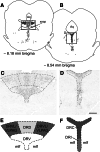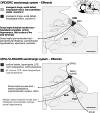Stress-related serotonergic systems: implications for symptomatology of anxiety and affective disorders
- PMID: 22484834
- PMCID: PMC3378822
- DOI: 10.1007/s10571-012-9827-1
Stress-related serotonergic systems: implications for symptomatology of anxiety and affective disorders
Abstract
Previous studies have suggested that serotonergic neurons in the midbrain raphe complex have a functional topographic organization. Recent studies suggest that stimulation of a bed nucleus of the stria terminalis-dorsal raphe nucleus pathway by stress- and anxiety-related stimuli modulates a subpopulation of serotonergic neurons in the dorsal part of the dorsal raphe nucleus (DRD) and caudal part of the dorsal raphe nucleus (DRC) that participates in facilitation of anxiety-like responses. In contrast, recent studies suggest that activation of a spinoparabrachial pathway by peripheral thermal or immune stimuli excites subpopulations of serotonergic neurons in the ventrolateral part of the dorsal raphe nucleus/ventrolateral periaqueducal gray (DRVL/VLPAG) region and interfascicular part of the dorsal raphe nucleus (DRI). Studies support a role for serotonergic neurons in the DRVL/VLPAG in inhibition of panic-like responses, and serotonergic neurons in the DRI in antidepressant-like effects. Thus, data suggest that while some subpopulations of serotonergic neurons in the dorsal raphe nucleus play a role in facilitation of anxiety-like responses, others play a role in inhibition of anxiety- or panic-like responses, while others play a role in antidepressant-like effects. Understanding the anatomical and functional properties of these distinct serotonergic systems may lead to novel therapeutic strategies for the prevention and/or treatment of affective and anxiety disorders. In this review, we describe the anatomical and functional properties of subpopulations of serotonergic neurons in the dorsal raphe nucleus, with a focus on those implicated in symptoms of anxiety and affective disorders, the DRD/DRC, DRVL/VLPAG, and DRI.
Figures



References
-
- Abrams JK, Johnson PL, Hay-Schmidt A, Mikkelsen JD, Shekhar A, Lowry CA (2005) Serotonergic systems associated with arousal and vigilance behaviors following administration of anxiogenic drugs. Neuroscience 133:983–997 - PubMed
-
- Amaral DG, Cowan WM (1980) Subcortical afferents to the hippocampal formation in the monkey. J Comp Neurol 189:573–591 - PubMed
-
- Amat J, Tamblyn JP, Paul ED, Bland ST, Amat P, Foster AC, Watkins LR, Maier SF (2004) Microinjection of urocortin 2 into the dorsal raphe nucleus activates serotonergic neurons and increases extracellular serotonin in the basolateral amygdala. Neuroscience 129:509–519 - PubMed
-
- Amat J, Baratta MV, Paul E, Bland ST, Watkins LR, Maier SF (2005) Medial prefrontal cortex determines how stressor controllability affects behavior and dorsal raphe nucleus. Nat Neurosci 8:365–371 - PubMed
-
- Azmitia EC, Gannon PJ (1986) The primate serotonergic system: a review of human and animal studies and a report on Macaca fascicularis. In: Fahn S et al (eds) Myoclonus. Raven Press, New York, pp 407–468 - PubMed
Publication types
MeSH terms
Substances
Grants and funding
LinkOut - more resources
Full Text Sources
Other Literature Sources
Medical

